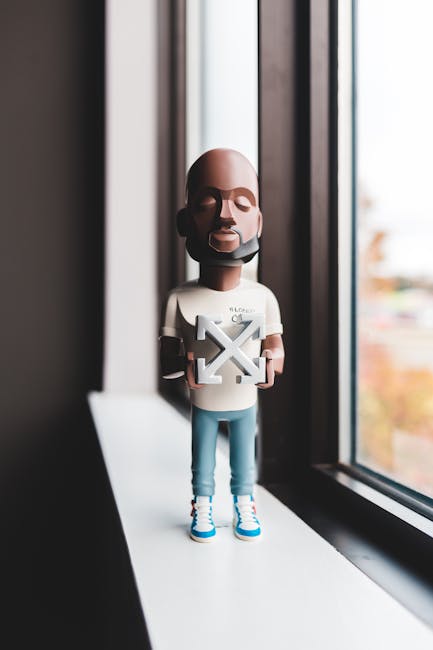
Step into the colorful world of logo design, where harmony meets boldness in a tantalizing tango of creativity! In this article, we will unravel the mysterious art of logo design and explore how designers magically transform mere shapes and colors into powerful visual identities. So buckle up, dear reader, as we embark on a whimsical journey through the pixels and puns of the logo design universe. Let’s dive headfirst into the kaleidoscopic chaos of branding and emerge victorious, one quirky logo at a time!
Exploring the Purpose of Logo Design
Logos are like the secret agents of the branding world. They are the silent ambassadors that represent a company, product or service without saying a single word. But have you ever stopped to think about the deeper purpose of logo design? Let’s peel back the layers like an onion and uncover the true essence of why logos exist.
First and foremost, logos are like the faces of a brand. Just like how we recognize and remember people by their faces, logos are the visual cues that help us identify and connect with a particular brand. It’s like playing a game of “Guess Who” but with company logos instead of people’s faces. And let’s be real, who doesn’t love a good guessing game?
Secondly, logos serve as a way to communicate a brand’s personality and values. Whether it’s sleek and modern or quirky and fun, a logo gives us a glimpse into what a brand stands for. It’s like a sneak peek into the brand’s inner circle, except instead of finding juicy gossip, you find design elements and color palettes.
And let’s not forget the most important purpose of logo design - to make a lasting impression. A well-designed logo sticks in our brains like a catchy jingle from a commercial. It’s the key to creating brand recognition and building trust with consumers. So next time you see a logo, remember that it’s not just a pretty picture – it’s a powerful tool with a purpose!
Understanding the Elements of a Strong Logo
So you want to create a logo that really pops, huh? Well, you’ve come to the right place! Let’s break down the key elements that make a logo stand out from the crowd:
- Simple: Keep it clean and straightforward. Your logo shouldn’t look like a Picasso painting – unless, of course, you’re a fancy art dealership.
- Memorable: Your logo should stick in people’s minds like that catchy jingle you can’t get out of your head. Think of it as the earworm of the visual world.
- Relevant: Make sure your logo reflects your brand and what you stand for. No one wants to see a surfboard in the logo of a snow shoveling company.
- Versatile: Your logo should work in any situation, whether it’s on a billboard, a business card, or even tattooed on a superfan’s arm. Flexibility is key, my friend.
So, there you have it – the recipe for a killer logo! Remember, a logo isn’t just a pretty picture; it’s the face of your brand. So, put on your creative hat (or beanie, we don’t judge) and start sketching up a storm. Who knows, maybe you’ll create the next Nike swoosh – or the next, well, “unique” fast-food logo.

Embracing Simplicity in Design
When it comes to design, less is definitely more. not only makes your work look clean and elegant, but it also helps convey your message more effectively. By stripping away unnecessary elements, you can really make your design stand out!
Forget about cluttering your work with excessive patterns, gradients, and textures. Instead, opt for a more minimalistic approach. Let your design breathe and give each element room to shine. Remember, simplicity is the ultimate sophistication!
Try using a limited color palette to create a cohesive and harmonious look. Bold colors can pack a powerful punch, so don’t be afraid to use them sparingly to draw attention to key elements. And when it comes to typography, less is more. Choose a clean, simple font that is easy to read and pair it with a complementary typeface for added interest.
So the next time you sit down to design something, remember to keep it simple. Your work will thank you for it! Embrace the beauty of simplicity and watch your designs take on a whole new level of sophistication.

Using Color Theory to Make an Impact
Color theory is like the secret code to unlocking the hidden powers of the rainbow. Forget about tasting it – we’re talking about harnessing it! By understanding how colors work together, you can create designs that leave an impact so potent, it’ll make people question whether they’re actually seeing in color or just dreaming in monochrome.
Mixing and matching colors isn’t just for fashionistas trying to decide between teal and aquamarine. It’s a science – a deliciously colorful science that can turn your bland designs into works of art that would make even Bob Ross shed a happy tear. By playing around with the color wheel, you can create harmonious combinations that evoke emotions and spark creativity.
Remember, colors have personalities too! Just like your kooky Aunt Linda who swears she’s “one with the universe” but also hoards cats, each color brings its own unique vibes to the table. From the fiery passion of red to the Zen-like calm of blue, choosing the right colors can set the mood for your designs faster than you can say “ROYGBIV.” So, next time you’re stuck in a creative rut, give color theory a whirl and watch your designs pop like a can of soda under a lawn mower.
Incorporating Typography for Brand Identity
Typography can make or break a brand identity - it’s like the font equivalent of choosing the right outfit for a job interview. You want to convey professionalism, style, and a touch of personality. So, let’s dive into how you can incorporate typography to make your brand stand out from the crowd!
First things first, choose fonts that reflect the vibe you want to convey. Are you sleek and modern like a sports car, or quirky and fun like a llama wearing sunglasses? Bold, sans-serif fonts can scream confidence, while elegant serif fonts can whisper sophistication. Remember, typography is like the wingman of your brand – it should complement your message, not overshadow it.
Next, consistency is key. It’s like sticking to a diet – you don’t want to be mixing Helvetica with Comic Sans like a salad topped with donuts. Create a brand style guide to keep your fonts in check. Set guidelines for headings, body text, and any other text elements you use. Stick to a few key fonts to maintain that brand recognition – too many fonts can be like inviting all your exes to the same party: chaos.
And don’t forget about hierarchy! Just like in a medieval kingdom, not all text is created equal. Use different font sizes, weights, and styles to create a visual hierarchy that guides your audience through your content. **Praise the almighty hierarchy!** Whether it’s a bold headline that shouts “HEY, LOOK AT ME!” or a subtle italicized quote that whispers sweet nothings, make sure your typography tells a story that keeps your brand at center stage. And remember, when in doubt, just add more exclamation points!!!!!!!
Striking a Balance Between Tradition and Innovation
In today’s ever-evolving world, it can be a challenge to find the perfect balance between embracing tradition and welcoming innovation. It’s like trying to mix oil and water – they don’t always blend seamlessly, but with a little creativity and open-mindedness, you can strike a harmonious equilibrium.
One way to blend tradition and innovation is to take a classic recipe and put a modern twist on it. For example, imagine a grandma’s secret meatloaf recipe infused with avocado and quinoa. It may sound unconventional, but hey, you never know until you try!
Another approach is to update traditional practices with new technology. Think about incorporating virtual reality into your annual family reunion or using drones to capture stunning aerial shots of your traditional holiday celebrations.
At the end of the day, finding the sweet spot between tradition and innovation is all about experimentation and keeping an open mind. So go ahead, mix things up, break the mold, and who knows, you might just discover a perfect harmony between the old and the new.
FAQs
What constitutes a successful logo design?
Success in logo design is a delicate balance of harmony and boldness. A successful logo should be visually appealing, memorable, versatile, and effectively communicate the brand’s message. It should be harmonious in its design elements but bold enough to stand out from the competition.
How important is color selection in logo design?
Color selection in logo design is crucial! Colors can evoke certain emotions and perceptions, so choosing the right color palette can help create the desired brand image. Whether it’s vibrant and bold or subtle and calming, colors play a significant role in how a logo is perceived by consumers.
What role does simplicity play in logo design?
Simplicity is key in logo design. A simple and clean logo is more memorable and versatile, making it easier for consumers to recognize and remember the brand. Remember, sometimes less is more!
How can designers achieve harmony in logo design?
To achieve harmony in logo design, designers need to carefully consider the elements of the logo, such as shape, typography, and color. These elements should work together seamlessly to create a cohesive and balanced design that reflects the brand’s identity.
Is it important for a logo to be unique and stand out?
Absolutely! In a sea of logos, it’s crucial for a logo to be unique and stand out from the competition. A bold and eye-catching logo can help a brand distinguish itself and leave a lasting impression on consumers.









